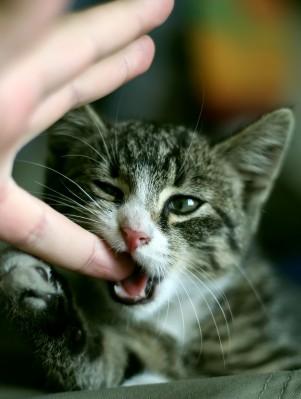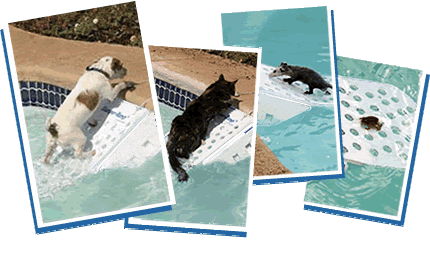If cats get bored, it’s quite possible they’ll go looking for something to do, and it’s usually not what the owner wants.
“A cat can get bored if they’re alone too much, if there’s not enough mental stimulation,” said Marva Marrow, a certified cat behavior consultant in Southern California. “Sometimes they can just get apathetic, but other times they can actually become destructive. They can also just look for things around the house that they can destroy or knock down or make a mess of, like tearing up the toilet paper, knocking things over or getting into cupboards. Or they can also be destructive to themselves, such as licking off their fur or biting their tails.”
Such behavior can cause concerned and loving pet owners to wonder what’s best for their cats: keeping them inside, safe from predators and infectious diseases; or letting them out, where there’s more stimulation.
“Some people go through the dilemma of ‘Should I let my cat outside?’ because it would open up a whole new world,” said Susan Southwick, co-owner of Animal Spirit in Cambridge, Mass. “Some people reluctantly let their cats be indoor-outdoor cats because they assume their cats are happier outside.
See this Blog's September 8th Post titled "Indoor Cats Can Play Outdoors" that describes the KittyWalk System of interconnected fully enclosed outdoor cat play yards.
Fortunately, you can also help keep cats indoors and safe by providing the most stimulating environment possible. Products such as toys; furniture that enables cats to scratch, rest or watch outside activity; and even bird feeders creates a winning situation for everyone.
Cat owners may or may not know that their cats are bored, —especially if they work a lot and the cat spends a lot of time alone.
Understanding cats and their behavioral motivations can help in selecting the best products for any given cat.
“Even when they live among humans and are well-fed, cats are natural hunters and their instinct to hunt remains strong,” said Jerry Spelic, marketing manager for OurPet’s Co., in Cleveland. “With no natural prey in their indoor environment, they express their hunting instincts by chasing imaginary prey.”
At the Cat Shoppe and the Dog Store in Nashville, Chris Achord recommends to her customers toys that appeal to cats’ senses, such as sparkle balls for vision, catnip toys for scent (she especially likes cigar-shaped catnip toys), and toys that make bird-like flutters and rodent-like sounds. She’s on to something.
Cats like to hunt birds, bugs and small rodents, said C. A. Tony Buffington, DVM, PhD, Diplomate ACVN, a professor at the Department of Veterinary Clinical Sciences at Ohio State University, which runs the Indoor Cat Initiative. Some cats don’t have a bird, bug or small-rodent preference, but some do. Helping customers decipher if their cats have such preferences and, if so, which ones, can pair cats up with toys best matching their personalities—that will help make sales.
Ask yourself if your cat shows any preferences for one type of toy over another. Do they prefer laser pointers over other toys? Those that mimic bugs? Do they like fuzzy toys or even, say, attack cotton balls on the floor? If so, they prefer rodents.
“When I make recommendations for change,” Dr. Buffington said, “I [offer choices] and say, ‘Here are some things that, in my experience, worked really well for some people. Some of these might interest you, and I can help you with you that. And if they don’t, maybe it will help stimulate your thinking for something that will work for you.’ And I do find that clients respond to that.”
Mud Bay’s website contains information to help bring up the topic, including a brochure called “For Healthy and Happy Indoor Cats.”
“It includes information about transitioning an outdoor cat to an indoor lifestyle, toy selection based on hunting preferences, importance of play, feline scent communication, cats’ territorial needs, introducing new cats to existing dogs and cats, hairball control and a few other topics,” Kells said.
Even after careful toy selection, though, cats can still grow tired of them. Rotating toys keeps things fresh for cats, which is especially important for cats alone during the day. It also leads to additional sales. For optimal play response try only setting out one or two toys at a time, suggested Marrow, “and rotate them on a weekly basis because [cats] get bored playing with the same thing over and over for the most part.”
Toys aren’t the only things that keep cats from getting bored. Myriad products stimulate them and keep them busy. Tall posts enable cats to stretch and align their spines, while channeling natural scratching instincts. Cat trees provide exercise, scratching surfaces, and help stimulate their hunting instincts.
“Cats are the most three-dimensional mammal we come in contact with,” Buffington said. “In fact, when they’re looking for prey or hiding from predators, they climb.”
Lipscomb suggested owners get cats trees, since the animals like to be in high places, and “they feel more secure if they’re up high surveying their territory.” Window seats for cats or shorter cat trees in front of windows enable cats to watch birds and other little animals outside. Achord even sells bird feeders and birdhouses in her store.
Lipscomb said sturdy, well-made furniture is a must for safety.
Jeff Simpson, president of Mr. Herzher’s Pet Accessories with Style in Auburn, Ala., agreed and added that nice-looking, well-constructed furniture that is made with quality  materials sells even in tough economic times. Click on picture for examples of several styles.
materials sells even in tough economic times. Click on picture for examples of several styles.
“There’s a segment of the consumer population that’s willing to pay for quality from a manufacturing materials standpoint, as well as an aesthetic standpoint,” he said.
“Once people find a perch their cat likes, its placement is really important,” Kells said. “Some cats love perching in a window, where they can watch people and cars go by. Other cats prefer windows that look out on wooded areas, where they can watch birds, raccoons and other wildlife. Then there are those cats who like to watch TV.”
Whether it’s woodland animals, birds or the television, it’s all the same concept: motion.
“[Cats] have these little motion detectors in their eyes, and as soon as something moves, they want to get on it right away,” Lipscomb said. “So movement is a big thing.”
Some people may know this, others might not. Owners should figure out what keeps their cats busy and happy.
Window perches are viable options for pet owners looking to provide a window of entertainment to the great outdoors for their cats. Courtesy of Mr. Herzher’s—Pet Accessories with Style Available through www.blueridgepetcenter.com
Cats Need Play, Too
They may not seek attention as readily as dogs do, but cats still need stimulation to keep their minds active and healthy.
“The unique thing about cats is that they’re not a pack species,” said C. A. Tony Buffington, DVM, PhD, Diplomate ACVN, a professor at the Department of Veterinary Clinical Sciences at Ohio State University.
“They’re an independent species. We as humans—we’re a pack species; dogs are a pack species, horses, cattle, sheep, ducks, pigs all the rest pretty much.”
That independent streak may lead some to believe that cats enjoy being alone. While they do sleep about 18 hours per day, some customers may not realize they haven’t given their cats enough to do throughout the day when they’re awake and alone.
“When they wake up, watch out,” said Betsy Lipscomb, who is co-owner of product manufacturer SmartCat and is a cat behaviorist who runs CatsInternational.org. “They need to have a little stimulation once they are awake.”
Many toys are designed to keep cats entertained while they’re unsupervised, such crinkle balls, fuzzy mice, balls that have food them—they can work for food like in the wild—or balls on tracks that work as games, all contribute to their mental stimulation.
But that doesn’t mean they don’t appreciate time with their humans. Cats love to interact with their humans, and it benefits them physically, too.
“They probably get more exercise playing with owners than just by playing with themselves,” said Chris Achord, owner of the Cat Shoppe and the Dog Store in Nashville.
Remember to put interactive toys, such as wands, feathers, fishing poles and so on, away so cats don’t have access to them when unsupervised. Many customers may be aware they need to do this, while others may not have thought about it or have just adopted a cat for the first time. A reminder never hurts.
Hot Sellers per Pet Product News
So, which toys are retailers selling like crazy?
- CatCharmer (CatDancer)
- Catnip Cigars (DuckyWorld)
- Da Bird (Go-Cat)
- Wubba Cat (Kong Co.)
- SlimCat treat ball (MultiVet)
- Play-N-Squeak hunting instinct toy line (OurPet’s Co.)
- Boca Rat (Kittybird)
- Peek-and-Play Toy Box (SmartCat)
Toys for Unsupervised Cats
People who want to pamper their cats that are left home alone have a variety of choices available to them, including:
- Crinkle balls
- Fuzzy mice
- Balls with rattles inside
- Plushy balls
- Sparkly balls
- Catnip toys
- DVDs featuring other animals in the wild, to engage the hunting instinct
- CDs of calming music
- Scratching posts and surfaces
- Cat furniture (including trees, towers, wall-shelving and window perches)
- Puzzle games (such as balls on tracks or treat-dispensing toys)
Interactive Toys
Toys that encourage the human-feline bond come in all shapes and sizes, such as:
- Peacock feathers
- Laser pointers
- Fishing poles
- Wand toys
- Teasers
- Bubbles
Some Material from an article By Elisa Jordan
What is meant by "Kittywalk® Systems"?
The Systems in Kittywalk© Systems refers to the inter-connectivity of the different outdoor pet components. They can go together in a variety of different configurations giving you and your indoor pets a wide variety of options to enjoy the great outdoors.














 Manufacturers’ latest foraging toy designs are meant to mimic the wild and strengthen cats’ natural hunting instincts. Courtesy of OurPets’s
Manufacturers’ latest foraging toy designs are meant to mimic the wild and strengthen cats’ natural hunting instincts. Courtesy of OurPets’s






.jpg)
.jpg)


















 Manufacturers’ latest foraging toy designs are meant to mimic the wild and strengthen cats’ natural hunting instincts. Courtesy of OurPets’s
Manufacturers’ latest foraging toy designs are meant to mimic the wild and strengthen cats’ natural hunting instincts. Courtesy of OurPets’s


 We can’t imagine life without pets, but keeping up with pet messes can be a challenge. From trapping and locking pet hair to managing muddy paws and more, Swiffer gives pet cleaning a whole new meaning.
We can’t imagine life without pets, but keeping up with pet messes can be a challenge. From trapping and locking pet hair to managing muddy paws and more, Swiffer gives pet cleaning a whole new meaning.









